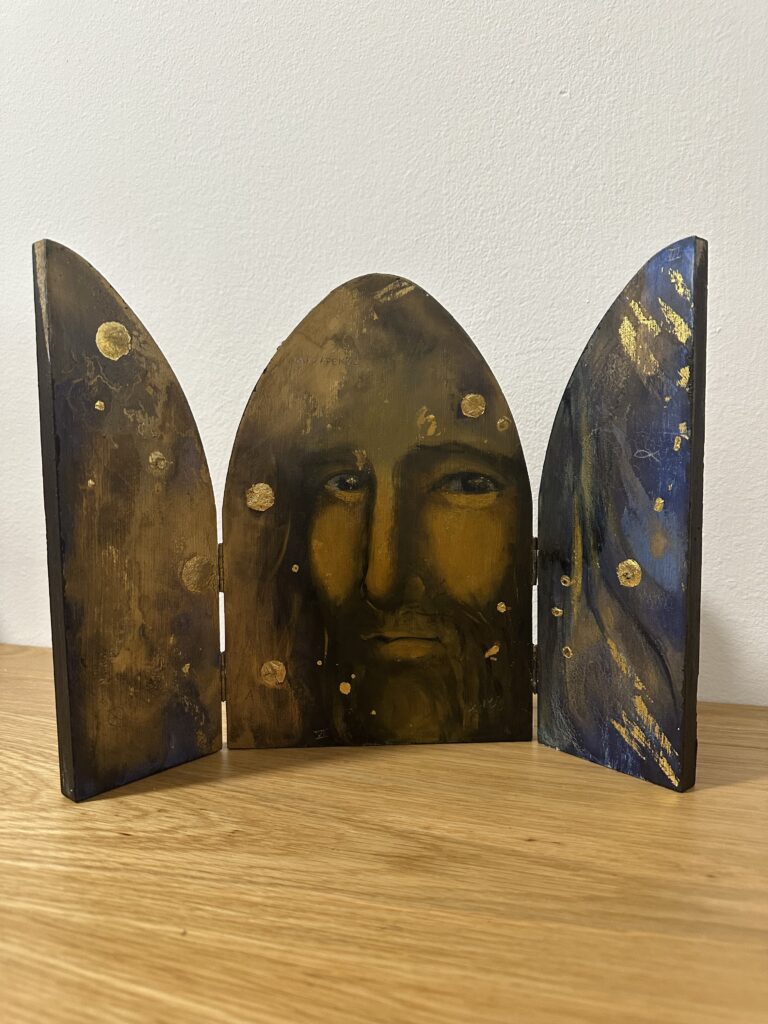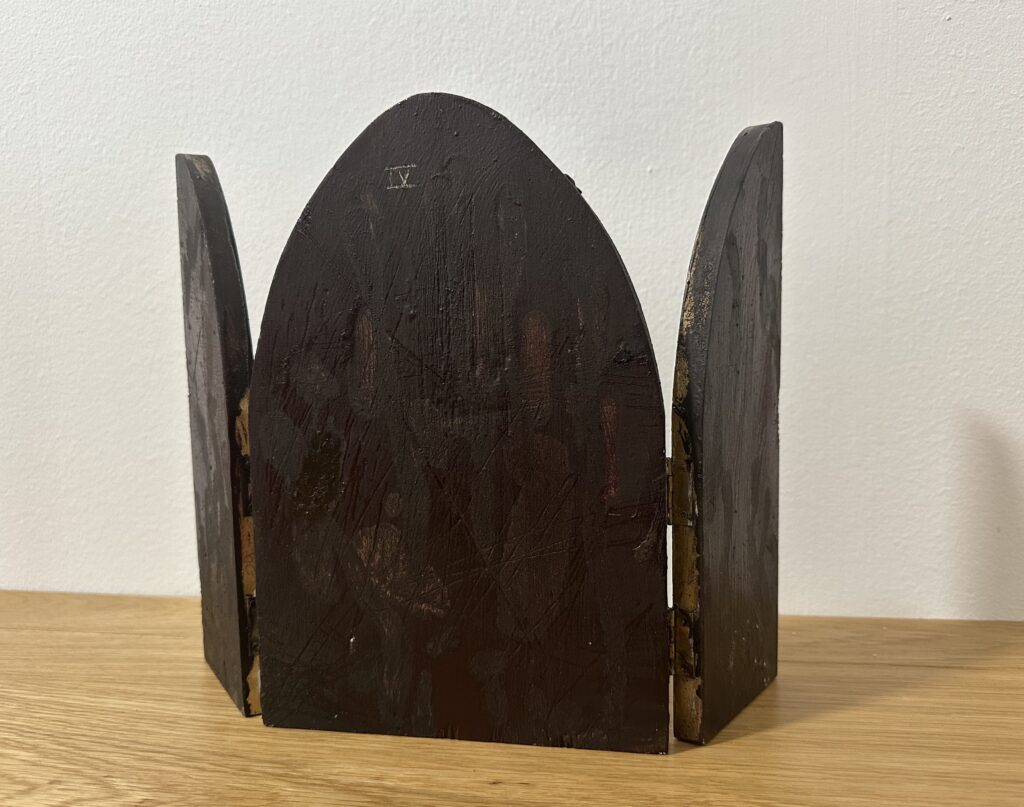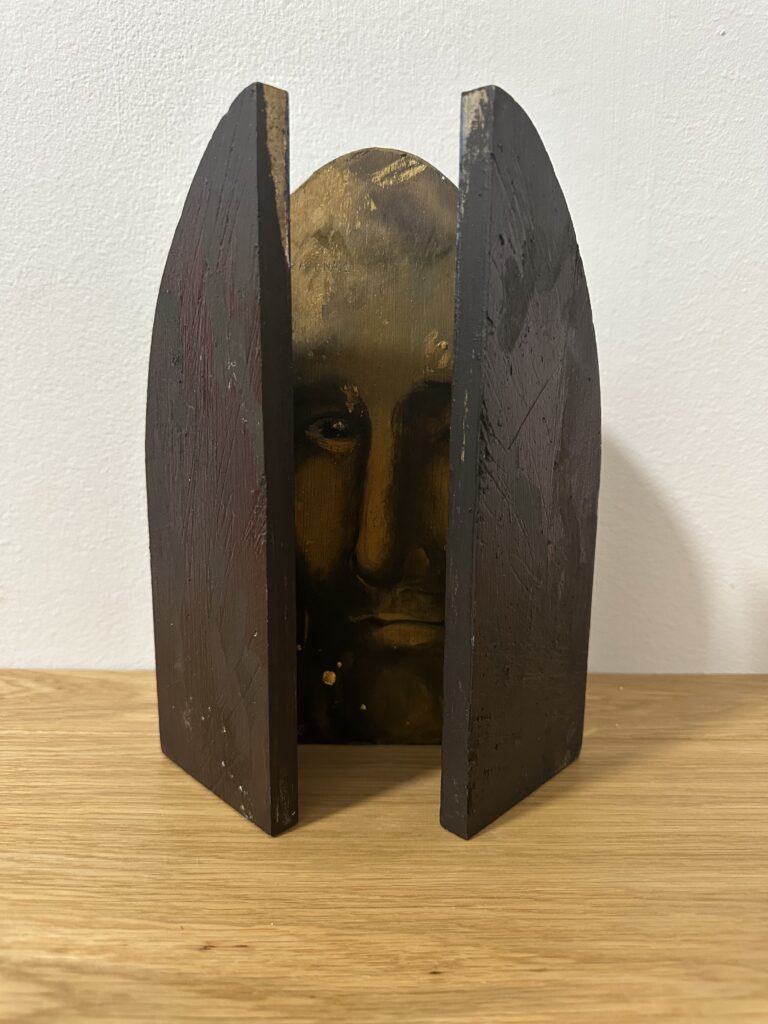🇮🇹La versioni in inglese e in francese seguono l’articolo in italiano🇮🇹
🇬🇧English and French translations are following the Italian text🇬🇧
🇫🇷Les traductions en anglais et en français suivent le texte en italien🇫🇷
Questa volta, ci accompagna L’Enciclopedia dei Simboli di Hans Biederman edita Garzanti.
Ho scelto di affrontare insieme questi due colori, marrone e oro, perché spesso li uso nella mia arte associati nella stessa opera e in contrapposizione tra loro.
Prima di consultare il manuale che ho scelto per questo articolo, proviamo ad andare “di impulso”. Che cos’è marrone? La terra, il fango, l’argilla, la materia dalla quale può nascere qualcosa, che sia una pianta o una statua modellata. Il marrone ci riconduce quindi alla sfera materiale, terrestre; il marrone è “solido”, materico, si può toccare; non come l’etereo azzurro ad esempio che è impalpabile e leggero.
Prendendo in mano il libro, leggiamo: “Per gli psicologi, il marrone puro agisce in modo <<caldo, riposante, materno, prossimo ai fatti semplici>>“. Sembra ricordare una calda alcova, la tana degli animali che protegge dal freddo invernale, là dove la vita riposa per poi rinascere. È collegato anche alla semplicità, che porta facilmente il pensiero al concetto di umiltà. Chi è semplice, privo di infrastrutture, spesso sa essere anche umile e si spoglia del superfluo, infatti, più avanti troviamo anche queste parole: “In ambito cristiano, il marrone è il <<colore del terreno, dell’autunno del lutto […] simbolo dell’umiltà>> (humilitas da humus, terra) e della povertà (<<di qui la tonaca marrone degli ordini mendicanti>>). Io a questo ragionamento aggiungo: che cosa fa l’uomo umile? Si inginocchia e si prostra a terra. Tutto torna.
Quindi, ricapitolando, il marrone è materico, legato alla terra, all’umiltà e alla semplicità.
Ovviamente, come quasi tutti i simboli, ha anche la sua accezione negativa, viene collegato anche al diavolo, sempre in contesto cristiano, ed è stato usato anche dal nazionalsocialismo di Hitler per le camicie delle SA. Anche nell’antico Egitto aveva carattere negativo, associato ad un dio maligno di nome Sutech, o Seth (quello con la testa di sciacallo per intenderci).
Ora cambiamo registro e vediamo cosa possiamo dire invece dell’oro. Metallo nobile per eccellenza, poche righe non basteranno per essere esaustiva sull’argomento, dovrò per forza tagliare delle informazioni anche preziose per concentrarmi di più su quegli aspetti simbolici che si avvicinano maggiormente alla mia ricerca artistica, altrimenti rischio solo di annoiarvi. Per chi fosse curioso, può sempre consultare o il libro che ho indicato inizialmente o un qualsiasi altro buon manuale di simbologia, troverà sicuramente tante possibilità di approfondimento in più.
L’oro è per la cultura cristiana (ma non solo) simbolo della luce divina. Possiamo dire che dove c’é oro, c’è Dio. Basti pensare agli sfondi dorati delle pale d’altare gotiche o alla luce dorata dei mosaici di Ravenna (su questi ultimi ci tornerò più avanti, a proposito dell’opera che ho scelto per accompagnare questo articolo). Del resto, non c’è nulla di più naturale che offrire quanto di più prezioso in terra per omaggiare il divino, no? Questa associazione simbolica, Dio-oro, è sicuramente stata tra le prime che l’uomo ha fatto da quando l’arte ha cominciato a parlare della sfera divina. L’oro è riflesso terreno della luce del sole, che anticamente era spesso associata alle divinità più importanti (si pensi al dio egizio Ra, o ad Apollo per gli antichi greci…). In Alchimia, l’oro è inteso come elevazione spirituale (e non come metallo materiale, attenzione!!) a cui l’adepto tende e verso il quale si avvicina attraverso le varie fasi di raffinazione della materia (intesa come anima da purificare). Su questo voglio fare un piccolo excursus di chiarimento perché finora ho notato qualche confusione tra le persone con sui mi sono trovata a parlarne. L’oro alchemico non è la pietra filosofale. La pietra filosofale è il mezzo attraverso il quale giungere all’oro, all’illuminazione, a Dio. Questo aspetto ha interessato molti teologi crisitiani medioevali perché ritrovavano un’assonanza con Cristo che è la via per giungere a Dio. L’associazione pietra filosofale-Cristo è risuonata nelle menti medioevali per molto tempo.
Tornando all’oro, possiamo anche dire che risuona nelle nostre menti come simbolo del potere, fino a poco tempo fa era il più raro e prezioso materiale al mondo, chi ne aveva di più, era sì il più ricco ma anche il più potente. Simbolo quindi di ricchezza, tripudio, abbondanza. Per sorridere un po’, vi chiedo: di che colore sono le infinite monete contenute nel deposito di Paperon de’ Paperoni?
L’oro è anche simbolo di purezza, riprendendo il discorso alchemico, esso è il risultato di progressive raffinazioni di una materia di partenza fortemente impura.
Bene, abbiamo quindi due colori che per un certo aspetto sono in contrapposizione: marrone-umiltà e semplicità, oro-trionfo del prezioso e del divino. Il marrone è “lo sporco del fango”, l’oro la purezza della luce creatrice.
Nell’opera che sto per presentarvi, questo dualismo è ben presente.
Viaggio è un piccolo trittico portatile, dipinto su legno nel 2017. Fa parte delle opere della mostra Tra Terra e Cielo Il Tuo Volto, la mia prima mostra personale. Il suo titolo è dovuto al riferimento storico artistico a quei dipinti-oggetti realizzati durante il medioevo con figure di santi che servivano alla devozione personale e che spesso, grazie alle ridotte dimensioni, seguivano chi li possedeva nei suoi viaggi.

In questa prima foto vedete il suo interno, con le due ali laterali aperte. Ho dipinto un volto di Cristo ad olio e ho realizzato lo sfondo con la mia tecnica personale che unisce la bomboletta spray al colore ad olio diluito. Vi è la presenza sia della foglia d’oro, sia di vari simboli paleocristiani, nonché di una citazione diretta di una scritta rinvenuta sulla Sindone. Vi sono numeri romani incisi, che celano messaggi riferiti alla numerologia, e anche qui i colori usati sono stati scelti tenendo conto delle loro valenze simboliche
Se l’interno è molto “ricco” (tutto quello che vedete in fotografia di color giallo-ocra è in realtà oro o doratura), l’esterno è invece spoglio, grezzo e di un solo colore, marrone, come potete vedere da quest’altra foto.

Avrei potuto creare un esterno altrettanto ricco dell’interno, lavorando la foglia d’oro cesellandola, rendendo l’opera più simile a quelle medioevali già citate. Credo anche di averci pensato, ma poi ho avuto un’ispirazione improvvisa, ricordandomi di una lezione di storia dell’arte sul Mausoleo di Galla Placidia a Ravenna (ricordate che all’inizio dell’articolo vi avevo detto che avrei parlato dei mosaici ravennati?). Il piccolo mausoleo è un vero e proprio scrigno contenente un tesoro meraviglioso. Qualora non vi ricordaste lo splendore interno della sua cupola, vi invito ad andarla a vedere anche brevemente su internet in questo momento. La croce dorata di Cristo, vero Dio, si staglia su un cielo cosparso di stelle luminose, sulle vele, i quattro simboli degli evangelisti sembrano veleggiare in questo mare di astri dorati; e dire che dal di fuori sembra un monumento così austero! Le mura esterne di questo piccolo edificio sono di semplicissimi mattoni di cotto, poche semplici decorazioni architettoniche ne aumentano il rigore più che lo splendore. Mi fa venire in mente una frase di William Shakespeare che ho scoperto da ragazzina: “È dentro ciò che solamente vale, e quello è qui, sempre con te rimane”. Il vero tesoro di Galla Placidia è all’interno delle sue semplici mura di mattoni e rimarrà per sempre, protetto da quelle mura possenti e glabre.
Viaggio, nel suo piccolo, vuole parlare di questo. Contenuto nel suo guscio esterno, umile, marrone, grezzo, vi è il Volto più prezioso di tutti, circondato di luce divina che Egli steso emana. Le luci del volto sono infatti dipinte proprio col colore ad olio dorato.
La presenza del blu è voluta come richiamo al Cielo (se non lo avete fatto, vi lascio leggere l’articolo precedente sui simboli legati al colore blu), e le ombre del volto sono realizzate con toni di marrone, non di nero. Cristo ha una doppia natura umana e divina: umana, terrestre e quindi l’ho dipinto anche col marrone, divina e quindi l’ho dipinto anche con l’oro. Proviene dai Cieli che sono presenti alle sue spalle e che si riflettono nei suoi occhi blu. Non dipingo Cristo con gli occhi blu per una tradizione secolare occidentale, li dipingo di questo colore perché se gli occhi sono le finestre dell’anima come diceva Leonardo, quelli di Cristo sono spalancati sulla sua anima celeste.

Concludo questo articolo molto lungo, dicendovi che Viaggio è un’opera del mio cuore, amata, voluta, sentita. Considero l’ispirazione a realizzare un esterno “povero” in contrapposizione ad un interno “ricco”, vera e proprio dono dall’Alto, del resto se l’Arte è nella mia vita è solo per Grazia Sua e a Lui sempre la dedicherò.
Giulia Calvanese
🇬🇧English translation🇬🇧
This time, we are accompanied by The Encyclopedia of Symbols by Hans Biederman published by Garzanti.
I chose to address these two colors together, brown and gold, because I often use them in my art associated in the same work and in contrast to each other.
Before consulting the manual I chose for this article, let’s try to go “on impulse”. What is brown? The earth, the mud, the clay, the matter from which something can be born, whether it is a plant or a modeled statue. Brown therefore brings us back to the material, terrestrial sphere; brown is “solid”, material, you can touch it; not like the ethereal blue for example which is impalpable and light.
Picking up the book, we read: “For psychologists, pure brown acts in a <<warm, restful, maternal way, close to simple facts>>”. It seems to recall a warm alcove, the den of animals that protects from the winter cold, where life rests and then is reborn. It is also connected to simplicity, which easily brings the thought to the concept of humility. Those who are simple, without infrastructure, often know how to be humble and strip themselves of the superfluous, in fact, further on we also find these words: “In the Christian context, brown is the <<color of the earth, of the autumn of mourning […] symbol of humility>> (humilitas from humus, earth) and poverty (<<hence the brown habit of the mendicant orders>>). I add to this reasoning: what does the humble man do? He kneels and prostrates himself on the ground. Everything makes sense.
So, to recap, brown is material, linked to the earth, to humility and simplicity.
Obviously, like almost all symbols, it also has its negative meaning, it is also linked to the devil, always in a Christian context, and it was also used by Hitler’s National Socialism for the shirts of the SA. Even in ancient Egypt it had a negative character, associated with an evil god named Sutech, or Seth (the one with the head of jackal to be clear).
Now let’s change register and see what we can say instead of gold. Noble metal par excellence, a few lines will not be enough to be exhaustive on the subject, I will have to cut out some precious information to focus more on those symbolic aspects that are closest to my artistic research, otherwise I risk only boring you. For those who are curious, you can always consult either the book I initially indicated or any other good symbology manual, you will surely find many possibilities for further study.
For Christian culture (but not only) gold is a symbol of divine light. We can say that where there is gold, there is God. Just think of the golden backgrounds of Gothic altarpieces or the golden light of the mosaics of Ravenna (I will return to the latter later, regarding the work I chose to accompany this article). After all, there is nothing more natural than offering the most precious thing on earth to pay homage to the divine, right? This symbolic association, God-gold, was certainly among the first that man made since art began to speak of the divine sphere. Gold is the earthly reflection of the light of the sun, which in ancient times was often associated with the most important divinities (think of the Egyptian god Ra, or Apollo for the ancient Greeks …). In Alchemy, gold is understood as spiritual elevation (and not as a material metal, be careful!!) to which the adept tends and towards which he approaches through the various phases of refining the matter (intended as a soul to be purified). On this I want to make a small excursus of clarification because so far I have noticed some confusion among the people with whom I have found myself talking about it. Alchemical gold is not the philosopher’s stone. The philosopher’s stone is the means through which to reach gold, enlightenment, God. This aspect interested many medieval Christian theologians because they found an assonance with Christ who is the way to reach God. The association philosopher’s stone-Christ resonated in medieval minds for a long time. Returning to gold, we can also say that it resonates in our minds as a symbol of power, until recently it was the rarest and most precious material in the world, whoever had the most was the richest but also the most powerful. Therefore a symbol of wealth, triumph, abundance. To smile a little, I ask you: what color are the infinite coins contained in Scrooge McDuck’s vault?
Gold is also a symbol of purity, taking up the alchemical discourse, it is the result of progressive refinements of a strongly impure starting material.
Well, we therefore have two colors that in a certain aspect are in opposition: brown-humility and simplicity, gold-triumph of the precious and the divine. Brown is “the dirt of the mud”, gold the purity of the creative light.
In the work that I am about to present to you, this dualism is very present.
Viaggio is a small portable triptych, painted on wood in 2017. It is part of the works of the exhibition Tra Terra e Cielo Il Tuo Volto, my first solo exhibition. Its title is due to the historical artistic reference to those paintings-objects made during the Middle Ages with figures of saints that served for personal devotion and that often, thanks to their small size, followed those who owned them on their travels.
In this first photo you see its interior, with the two lateral wings open. I painted a face of Christ in oil and created the background with my personal technique that combines spray paint with diluted oil paint. There is the presence of both gold leaf and various early Christian symbols, as well as a direct quote from an inscription found on the Shroud. There are engraved Roman numerals, which conceal messages referring to numerology, and here too the colors used were chosen taking into account their symbolic meanings
If the interior is very “rich” (everything you see in the photo of yellow-ochre color is actually gold or gilding), the exterior is instead bare, rough and of a single color, brown, as you can see from this other photo.
I could have created an exterior equally rich as the interior, working the gold leaf by chiseling it, making the work more similar to the medieval ones already mentioned. I think I even thought about it, but then I had a sudden inspiration, remembering an art history lesson on the Mausoleum of Galla Placidia in Ravenna (remember that at the beginning of the article I told you I would talk about the mosaics of Ravenna?). The small mausoleum is a real treasure chest containing a wonderful treasure. If you don’t remember the internal splendor of its dome, I invite you to go and see it even briefly on the internet right now. The golden cross of Christ, true God, stands out against a sky dotted with bright stars, on the sails, the four symbols of the evangelists seem to sail in this sea of golden stars; and to think that from the outside it seems like such an austere monument! The external walls of this small building are made of very simple terracotta bricks, a few simple architectural decorations increase its rigor more than its splendor. It reminds me of a phrase by William Shakespeare that I discovered as a girl: “It is within that which alone is valuable, and that is here, always with thee remains”. The true treasure of Galla Placidia is within its simple brick walls and will remain forever, protected by those mighty and smooth walls.
Viaggio, in its small way, wants to talk about this. Contained in its external shell, humble, brown, rough, there is the most precious Face of all, surrounded by divine light that He Himself emanates. The lights of the face are in fact painted with golden oil color.
The presence of blue is intended as a reference to Heaven (if you haven’t done so, I’ll let you read the previous article on the symbols linked to the color blue), and the shadows of the face are made with shades of brown, not black. Christ has a dual human and divine nature: human, earthly and therefore I also painted him with brown, divine and therefore I also painted him with gold. He comes from the Heavens that are present behind him and that are reflected in his blue eyes. I do not paint Christ with blue eyes for a secular Western tradition, I paint them this color because if the eyes are the windows of the soul as Leonardo said, those of Christ are wide open on his celestial soul.
I conclude this very long article, telling you that Viaggio is a work of my heart, loved, desired, felt. I consider the inspiration to create a “poor” exterior as opposed to a “rich” interior, a true gift from Above, after all if Art is in my life it is only by His Grace and I will always dedicate it to Him.
Giulia Calvanese
🇫🇷Version Française🇫🇷
Cette fois, nous sommes accompagnés de l’Encyclopédie des symboles de Hans Biederman publiée par Garzanti.
J’ai choisi d’aborder ces deux couleurs ensemble, le marron et le doré, car je les utilise souvent dans mon art associées dans la même œuvre et en contraste l’une avec l’autre.
Avant de consulter le manuel que j’ai choisi pour cet article, essayons d’y aller “par impulsion”. Qu’est-ce qui est marron ? La terre, la boue, l’argile, la matière à partir de laquelle quelque chose peut naître, que ce soit une plante ou une statue modelée. Brown nous ramène donc à la sphère matérielle, terrestre ; le marron est « solide », une matière, on peut le toucher ; pas comme le bleu éthéré par exemple qui est impalpable et léger.
En prenant le livre, nous lisons : « Pour les psychologues, le brun pur agit de manière « chaleureuse, reposante, maternelle, proche des faits simples » ». Elle semble rappeler une alcôve chaleureuse, le repaire des animaux qui protège du froid hivernal, où la vie se repose puis renaît. Elle est également liée à la simplicité, ce qui amène facilement la pensée au concept d’humilité. Ceux qui sont simples, sans infrastructures, savent souvent être humbles et se dépouiller du superflu. D’ailleurs, on trouve plus loin ces mots : « Dans le contexte chrétien, le marron est la « couleur de la terre, de l’automne du deuil […] symbole d’humilité » (humilitas, de humus, terre) et de pauvreté (d’où l’habit marron des ordres mendiants). J’ajoute à ce raisonnement : que fait l’homme humble ? Il s’agenouille et se prosterne à terre. Tout lui revient. »
Donc, pour résumer, le marron est une matière, liée à la terre, à l’humilité et à la simplicité.
Bien sûr, comme presque tous les symboles, il a aussi sa connotation négative, il est aussi lié au diable, toujours dans un contexte chrétien, et il a également été utilisé par le national-socialisme d’Hitler pour les chemises SA. Même dans l’Égypte ancienne, il avait un caractère négatif, associé à un dieu maléfique nommé Sutech, ou Seth (celui avec la tête de chacal, pour ainsi dire).
Changeons maintenant de registre et voyons ce que nous pouvons dire à la place de l’or. Métal noble par excellence, quelques lignes ne suffiront pas à être exhaustif sur le sujet, je devrai forcément couper certaines informations, même précieuses, pour me concentrer davantage sur ces aspects symboliques qui sont les plus proches de ma recherche artistique, sinon je risque de ne vous ennuyer que. Pour ceux qui sont curieux, vous pouvez toujours consulter soit le livre que j’ai indiqué initialement, soit tout autre bon manuel de symbologie, vous y trouverez sûrement de nombreuses possibilités d’études plus approfondies.
Pour la culture chrétienne (mais pas seulement), l’or est un symbole de lumière divine. On peut dire que là où il y a de l’or, il y a Dieu. Il suffit de penser aux fonds dorés des retables gothiques ou à la lumière dorée des mosaïques de Ravenne (je reviendrai sur cette dernière plus tard, à propos de l’œuvre que j’ai choisie pour accompagner cet article). Après tout, il n’y a rien de plus naturel que d’offrir la chose la plus précieuse sur terre pour rendre hommage au divin, n’est-ce pas ? Cette association symbolique, Dieu-or, fut certainement parmi les premières que l’homme ait créées depuis que l’art a commencé à parler de la sphère divine. L’or est un reflet terrestre de la lumière du soleil, qui dans l’Antiquité était souvent associé aux divinités les plus importantes (pensez au dieu égyptien Râ, ou à Apollon pour les anciens Grecs…). En Alchimie, l’or est compris comme une élévation spirituelle (et non comme un métal matériel, attention !!) vers laquelle tend l’adepte et vers laquelle il s’approche à travers les différentes phases d’affinage de la matière (entendue comme une âme à purifier). Je voudrais faire une petite digression de clarification à ce sujet car jusqu’à présent j’ai remarqué une certaine confusion parmi les personnes avec lesquelles j’en ai parlé. L’or alchimique n’est pas la pierre philosophale. La pierre philosophale est le moyen d’atteindre l’or, l’illumination, Dieu. Cet aspect a intéressé de nombreux théologiens chrétiens médiévaux, car ils y ont trouvé une assonance avec le Christ, qui est le chemin vers Dieu. L’association pierre philosophale-Christ a longtemps résonné dans les esprits médiévaux.
Pour en revenir à l’or, on peut aussi dire qu’il résonne dans nos esprits comme un symbole de pouvoir, jusqu’à récemment c’était le matériau le plus rare et le plus précieux au monde, celui qui en avait le plus était le plus riche mais aussi le plus puissant. C’est donc un symbole de richesse, de triomphe, d’abondance. Pour vous faire sourire un peu, je vous demande : de quelle couleur sont les pièces infinies contenues dans la réserve de Picsou ?
L’or est aussi un symbole de pureté ; pour revenir au discours alchimique, c’est le résultat de raffinements progressifs d’une matière première hautement impure.
Eh bien, nous avons deux couleurs qui, dans un certain sens, sont en opposition : le marron, l’humilité et la simplicité, l’or, le triomphe du précieux et du divin. Le marron est « la saleté de la boue », l’or est la pureté de la lumière créatrice.
Dans l’œuvre que je m’apprête à vous présenter, ce dualisme est très présent.
Viaggio est un petit triptyque portable, peint sur bois en 2017. Il fait partie des œuvres de l’exposition Tra Terra e Cielo Il Tuo Volto, ma première exposition personnelle. Son titre est dû à la référence historique et artistique à ces objets peints créés au Moyen Âge avec des figures de saints qui servaient à la dévotion personnelle et qui souvent, grâce à leur petite taille, suivaient leur propriétaire dans ses voyages.
Sur cette première photo, vous pouvez voir son intérieur, avec les deux ailes latérales ouvertes. J’ai peint un visage du Christ à l’huile et créé le fond avec ma technique personnelle qui combine la bombe aérosol avec de la couleur à l’huile diluée. On y retrouve à la fois des feuilles d’or et divers symboles chrétiens primitifs, ainsi qu’une citation directe d’une inscription trouvée sur le Suaire. On y trouve des chiffres romains gravés, qui cachent des messages relatifs à la numérologie, et ici aussi les couleurs utilisées ont été choisies en tenant compte de leurs significations symboliques.
Alors que l’intérieur est très « riche » (tout ce que vous voyez sur la photo qui est de couleur jaune-ocre est en fait de l’or ou de la dorure), l’extérieur est au contraire nu, rugueux et d’une seule couleur, le marron, comme vous pouvez le voir sur cette autre photo.
J’aurais pu créer un extérieur aussi riche que l’intérieur, en travaillant la feuille d’or en la ciselant, rendant l’œuvre plus semblable à celles médiévales déjà mentionnées. Je crois que j’y ai même pensé, mais j’ai eu une inspiration soudaine, me souvenant d’une leçon d’histoire de l’art sur le mausolée de Galla Placidia à Ravenne (vous vous souvenez qu’au début de l’article je vous ai dit que je parlerais des mosaïques de Ravenne ?). Le petit mausolée est un véritable coffre aux trésors contenant un merveilleux trésor. Si vous ne vous souvenez pas de la splendeur intérieure de son dôme, je vous invite à aller le voir même brièvement sur Internet dès maintenant. La croix d’or du Christ, vrai Dieu, se détache sur un ciel parsemé d’étoiles brillantes ; sur les voiles, les quatre symboles des évangélistes semblent naviguer dans cette mer d’étoiles dorées ; et dire que de l’extérieur cela ressemble à un monument si austère ! Les murs extérieurs de ce petit bâtiment sont faits de briques de terre cuite très simples, quelques décorations architecturales simples augmentent sa rigueur plutôt que sa splendeur. Cela me rappelle une citation de William Shakespeare que j’ai découverte quand j’étais petite : « Ce qui seul vaut la peine est à l’intérieur, et cela est ici, et reste toujours avec vous. » Le véritable trésor de Galla Placidia se trouve à l’intérieur de ses simples murs de briques et restera à jamais protégé par ces murs puissants et lisses.
Viaggio, à sa petite échelle, veut parler de cela. Contenu dans son humble enveloppe extérieure brune et rugueuse se trouve le Visage le plus précieux de tous, entouré de la lumière divine qu’Il émane Lui-même. Les lumières du visage sont en fait peintes avec de la peinture à l’huile dorée.
La présence du bleu est destinée à faire référence au Ciel (si vous ne l’avez pas déjà fait, je vous laisse lire l’article précédent sur les symboles liés à la couleur bleue), et les ombres sur le visage sont créées avec des nuances de brun, pas de noir. Le Christ a une double nature humaine et divine : humaine, terrestre et donc je l’ai aussi peint en marron, divine et donc je l’ai aussi peint en or. Cela vient des Cieux qui sont présents derrière lui et qui se reflètent dans ses yeux bleus. Je ne peins pas le Christ avec les yeux bleus à cause d’une tradition occidentale vieille de plusieurs siècles, je les peins de cette couleur car si les yeux sont les fenêtres de l’âme comme le disait Léonard, ceux du Christ sont grands ouverts sur son âme céleste.
Je conclus ce très long article en vous disant que Viaggio est une œuvre de mon cœur, aimée, désirée, ressentie. Je considère l’inspiration de créer un extérieur « pauvre » par opposition à un intérieur « riche », un véritable don d’En Haut, après tout si l’Art est dans ma vie, c’est seulement par Sa Grâce et je le Lui dédierai toujours.
Giulia Calvanese

